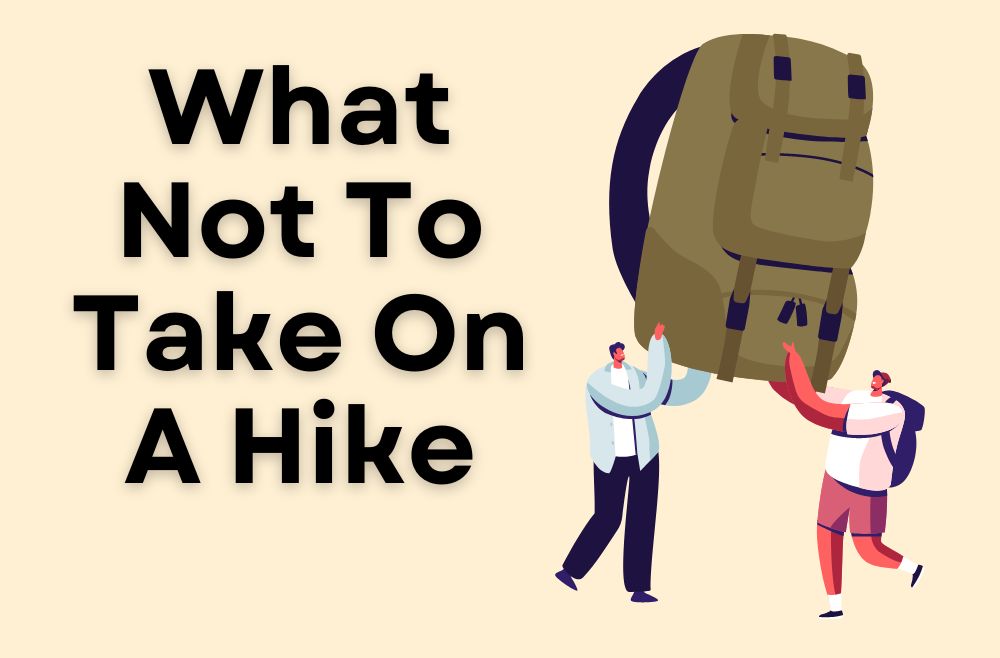Hiking can be an invigorating and rewarding experience, however, it’s important to know what not to take on a hike through the wilderness. As the saying goes, ‘less is more’ and this rings true when packing for a hike; too much of the wrong items can weigh you down like an anchor in rough seas.
This article will discuss five items that should be avoided while hiking: heavy or bulky items, unnecessary clothing and accessories, technology and electronics, valuables and important documents as well as too much food and water.
In This Article
Key Takeaways
- Pack light and bring only necessary items
- Choose practical clothing items that protect from the elements without being cumbersome
- Use technology and electronics judiciously to avoid unnecessary weight
- Pack only essential snacks, meals, and beverages and plan ahead for emergency sustenance or unexpected changes
Heavy or Bulky Items
It is not advisable to take heavy or bulky items on a hike due to the increased difficulty of transportation. The carrying of such outdoor gear adds extra weight and can quickly become cumbersome, making it difficult to move around.
Having too many items can lead to exhaustion quicker than expected, so it is important to pack light and only bring what is necessary.
Sun protection should be top priority when deciding which items to bring on a hike; sunglasses, sunblock, and hats are essential for keeping skin protected in sunny weather.
Lightweight layers are great for providing additional warmth if the temperature suddenly drops while out in nature.
Unnecessary Clothing and Accessories
Wearing unnecessary clothing and accessories on a hike can be a burden. It is important to think through the clothing items you are bringing with you, and make sure they are practical for the specific hikes you plan on taking.
Going too heavy on your wardrobe can be detrimental to your safety and success while hiking. To avoid this, bring items that will help protect you from the elements without being overly cumbersome.
| Item | Function |
|---|---|
| Hat | Avoid Sunburns |
| Sunglasses | Eye Protection From UV Rays |
| Wicking Undergarments | Keeps Body Temperature Balanced |
| Lightweight Jacket/Vest/Fleece Layer | Provides Warmth When Needed |
Technology and Electronics
When hiking, technology and electronics may be beneficial for some activities such as navigation, but should be used judiciously to avoid unnecessary weight. Using maps is a great way to navigate without the need of a GPS device or battery packs.
For those who do choose to bring GPS devices, it’s important to make sure they are fully charged before the hike and that extra battery packs are included in case the device runs out of power. Also, depending on the length of time spent on the trail, charging devices can come in handy if outlets are not available.
To save space and reduce weight, consider investing in charging devices that can charge more than one electronic at once. This will help ensure that only necessary items are taken with you during your hike.
Valuables and Important Documents
Carrying valuables and important documents on a hike is an important consideration for safety and security. Creating a detailed packing list before embarking on any outdoor excursion is essential in order to ensure all items necessary for personal safety, survival gear, and essential documents are accounted for.
Important documents such as passports or driver’s licenses should be securely stored in waterproof bags and kept on the person at all times. It is also advisable to leave copies of these documents with family or friends who are not accompanying the hiker in case of emergency.
Valuables such as jewelry, credit cards, or large amounts of cash should preferably be left at home; however if they must be taken on the hike they should never be left unattended when out in nature.
Too Much Food and Water
Bringing too much food and water on a hike can be counterproductive. In order to ensure an enjoyable experience, it is important for hikers to pack light and plan ahead. Here are three tips to help hikers avoid overpacking:
- Make sure to bring only the essentials – snacks, meals, and beverages should not exceed what is necessary for the planned hike duration.
- Store items in compact containers that are lightweight and easy to carry.
- Research the area before setting out so that you know what is available along the trail in case of emergency sustenance needs or an unexpected change in plans.
- McDougall, Len (Author)
- English (Publication Language)
- Skurka, Andrew (Author)
- English (Publication Language)
What’s Next?
The journey of a successful hike is not just about the physical obstacle, but also the mental and emotional preparation. It requires careful consideration to avoid taking items that may become burdensome or detrimental to the trek.
By being mindful of what not to take on a hike – heavy or bulky items, unnecessary clothing and accessories, technology and electronics, valuable documents and too much food and water – one can enjoy a safe and successful adventure with peace of mind.
To be ready for any challenge along the way, consider it as an allegory for life: when we prioritize our belongings judiciously in our everyday lives, only then can we appreciate true freedom from materialism’s chains.





We are participants in the Amazon Services LLC Associates Program, an affiliate advertising program designed to provide a means for sites to earn advertising fees by advertising and linking to Amazon.com